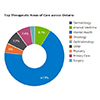About Rob Williams

Dr. Williams is the Chief Medical Officer for OTN. In this capacity, he provides strategic leadership, advocacy and support for the organization's medical interests.
Our Bloggers
Categories
More Info
OTN
Blogroll
Top Rated Blogs
Posts by Rob Williams
Written by Rob Williams
on December 16, 2015
 | In my previous post I reviewed some of the ways Telemedicine is being used across the province to support care of the elderly. In this post I’ll review findings from articles that explore the use and benefits of telemedicine in geriatrics.
A recent article published by Baycrest, compares a face-to-face session versus a telemedicine session for clinic-based group cognitive behavioural therapy (CBT) with adults who suffer from depression and anxiety. The results of which show that group CBT can be delivered in a technology... |
Comments
Written by Rob Williams
on November 24, 2015
 | There are tremendous opportunities for telemedicine use in the care of the elderly in both urban and rural settings. Typically, as people age they become mentally and physically infirm, which can make travelling distances problematic. This makes care of the elderly ideally suited for multiple streams of telemedicine.
OTN’s early applications of telemedicine for the elderly were to support elderly people in long-term care homes. Initially, OTN worked with long-term care homes to enable video, which allowed providers to consult over Videoconference and eliminated the need for the resident to travel. This was quickly adopted into cognitive assessments with geriatric psychiatry. Videoconferencing lends itself well to people who need... |
Written by Rob Williams
on July 30, 2015
Extension for Community Healthcare Outcomes, better known as Project ECHO, is a multi-disciplinary collaborative model of medical education and care management that helps increase access to specialty care and “de-monopolizes” specialized services. The model facilitates a virtual peer-to-peer group via video conference for primary care providers and empowers them with new knowledge to manage challenging patients with selective types of complex chronic diseases.
Project ECHO started in 2003 by looking at Hepatitis C, and has since evolved to include supporting patients with HIV, chronic pain, rheumatoid arthritis, and other chronic complex diseases. These diseases are often a challenge for a... | |
Written by Rob Williams
on July 30, 2015
Extension for Community Healthcare Outcomes, better known as Project ECHO, is a multi-disciplinary collaborative model of medical education and care management that helps increase access to specialty care and “de-monopolizes” specialized services. The model facilitates a virtual peer-to-peer group via video conference for primary care providers and empowers them with new knowledge to manage challenging patients with selective types of complex chronic diseases.
Project ECHO started in 2003 by looking at Hepatitis C, and has since evolved to include supporting patients with HIV, chronic pain, rheumatoid arthritis, and other chronic complex diseases. These diseases are often a challenge for a... | |
Written by Rob Williams
on March 3, 2015
In December 2014, The College of Physicians and Surgeons of Ontario (CPSO) reviewed and updated their Telemedicine policy, providing clarity on general expectations for telemedicine and specific expectations for practicing telemedicine across borders. I had the privilege of being part of the working group that developed the policy, along with CPSO Council, staff, and other external experts. For more than a year, the working group met regularly and took an in-depth review of the state of telemedicine around the world, including the positions and policies of other Colleges, provinces, territories, as well as international positions in other countries like the US,... | |
Written by Rob Williams
on June 19, 2014
 | Have you and your telemedicine colleagues ever wondered how often you use telemedicine compared to other areas of the province? Or how much telemedicine activity occurred in one LHIN versus another LHIN? Or what kinds of therapeutic areas of care were most popular over OTN’s network?
We’ve revamped the way we present our provincial and LHIN data to include historical information that can be displayed in a series of interactive Google Charts. Here’s a quick overview of what you can see with our new interactive LHIN charts (click to view):
... |
Written by Rob Williams
on May 2, 2014
Health & Wellness App: Screenshot from <30 Days iPhone app by Heart and Stroke Foundation of Canada
Apps have grown in popularity over the last few years; in fact, Apple’s App Store has over a million apps with many focusing on healthcare. Suffice to say, apps are becoming very important to consumers in North America. I see apps as being in two categories: the first category is wellness, for example apps that deal with smoking cessation, weight loss, healthy eating choices, lifestyle issues for hypertension, etc. These apps can be useful as coaching aids for people to self-manage. The second category is apps that assist... | |
Written by Rob Williams
on March 6, 2014
The future of virtual care is mHealth – incorporating mobile devices into the delivery of virtual services. Recently, I wrote about how OTN is offering Personal Videoconferencing on a personal computer, so you don’t need to go to a room-based studio with a codec and a camera. Instead, you can download software onto a personal computer, and conduct the consultation over that device via the internet with other endpoints, whether it’s a Personal Videoconferencing device or a room-based studio. Eventually this functionality will be extended to any mobile device – tablet or... | |
Written by Rob Williams
on February 4, 2014
Ontario’s newest innovation in virtual care continues OTN’s leadership in the field. Finally, technology has been developed that facilitates care delivery through the Internet, on PCs or laptops, with sharp clear images and little transmission delay.
OTN CEO Dr. Ed Brown on Personal Video Conferencing.
Sign up for Personal Videoconferencing.
Any member of the Ontario healthcare community can apply to use OTN’s Personal Videoconferencing service. Specialists, whose expertise may be unavailable in communities across Ontario, can now provide care in real-time from their home or office, thereby extending the reach of their practice. Travel time for the consultant... | |
Written by Rob Williams
on January 8, 2014
OTN was established in 1997 with the vision that telemedicine will be a mainstream channel for healthcare delivery and education. There were several barriers initially including startup costs, a compelling business case, a process for scheduling events, paying doctors, and overcoming health care professionals’ (HCP) resistance to using the technologies. A business and operational strategy was developed, always keeping in mind the need to be as easy and convenient to use as face-to-face encounters.
OTN currently has four channels of virtual care:
Elective Virtual Ambulatory Care: Last year OTN supported over 300,000 provider/patient real-time video consultations in over 40 specialty services. The top 5 therapeutic... | |
Pages

OTN is an independent, not-for-profit
organization funded by the
Government of Ontario.





